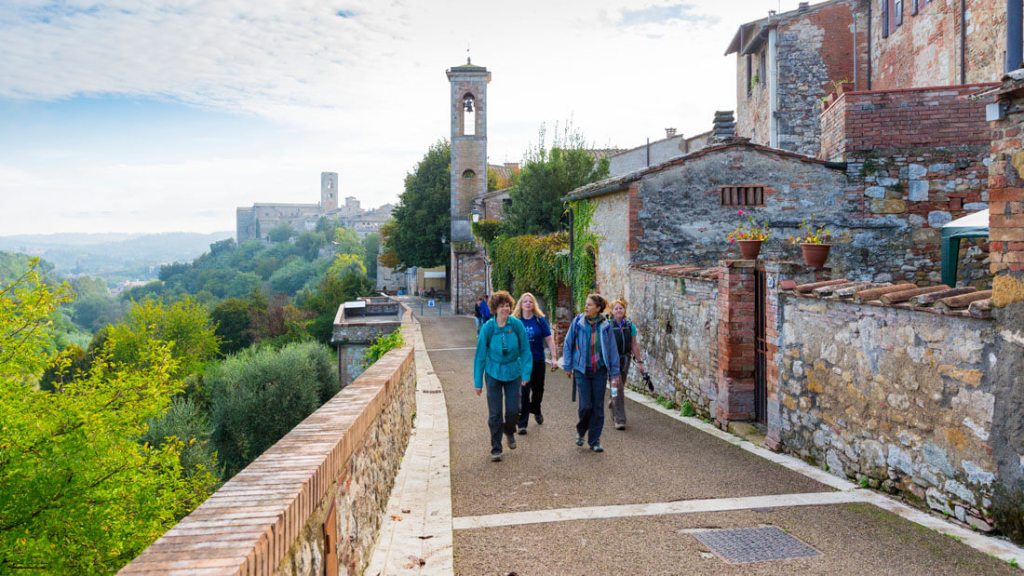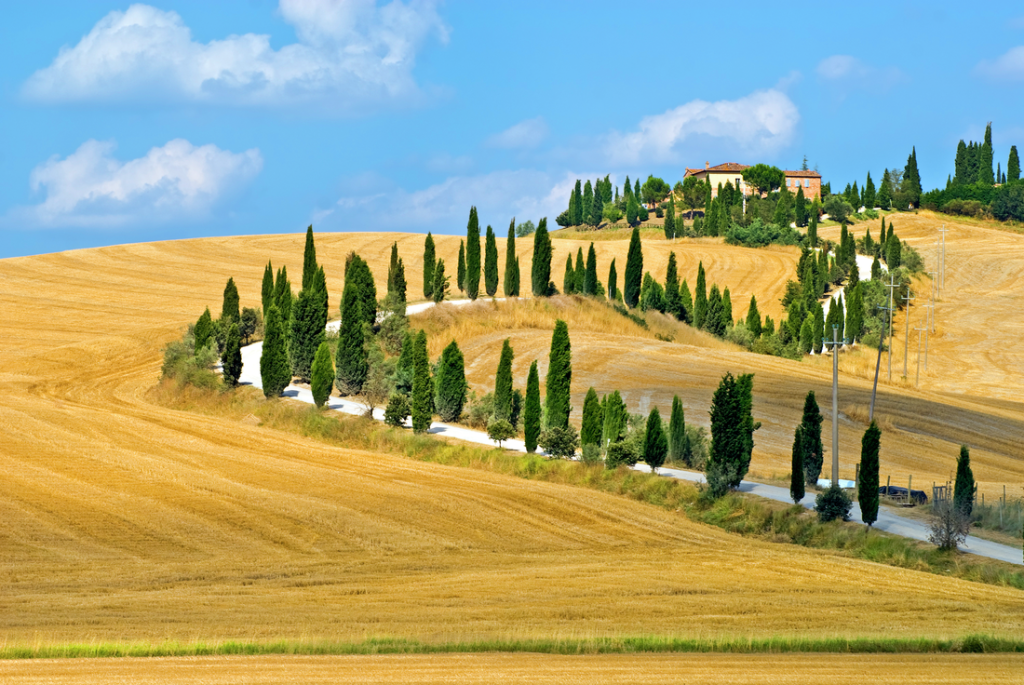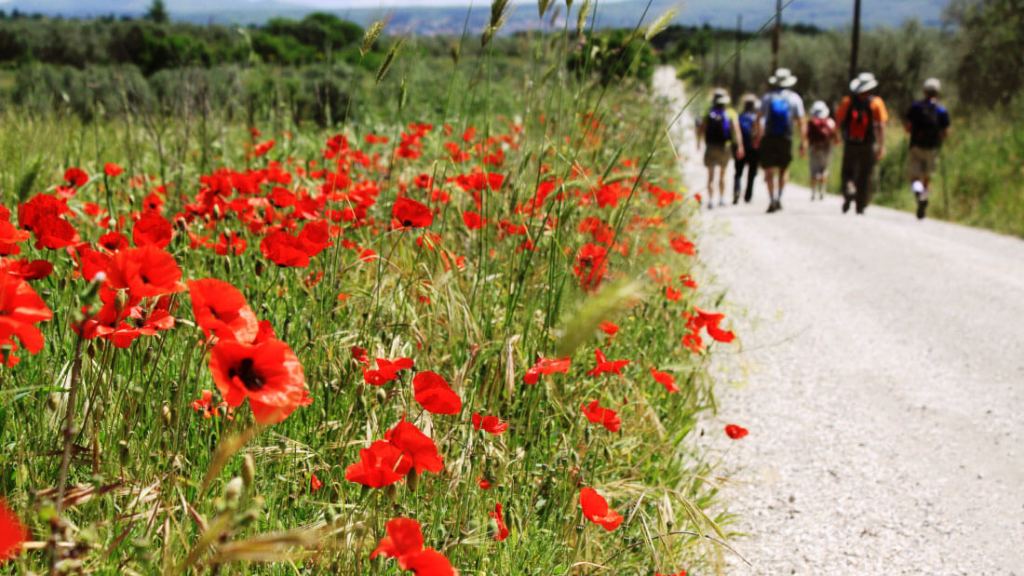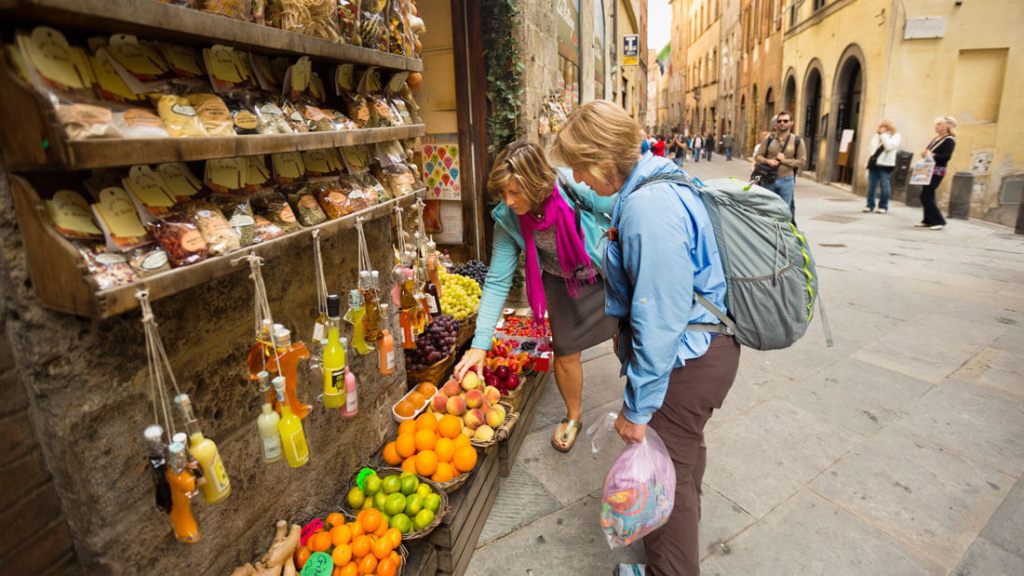Tuscany, the birthplace of the Italian Renaissance, is world famous for its wealth of art and architectural gems, superb red wines and farm-to-table cuisine. It’s one of the most-visited places in Italy for these reasons, but there are also wild areas—from its Mediterranean coast to its hills and mountains—where active travelers can find adventure.
While no trip to Tuscany is complete without a visit to Florence, this guide will cover areas outside that city, away from the crowds. So, if you’re just starting to think about an adventure trip to Tuscany, this guide will cover a sampling of where to go and what to do, including:
Why Visit Tuscany?
In Tuscany’s capital city of Florence, visitors line up to see Michelangelo’s David, and in quieter Pisa, the Leaning Tower is a perennial favorite. But before (and after) you join the crowds at these iconic destinations, why not explore Tuscany farther afield?
Earn your evening’s wine-and-cheese courses by cycling to a vineyard, or biking to a medieval hill town. Go sailing, snorkeling or diving off the coast of a Tuscan island. Walk a forest path, take a pilgrimage or run on an ancient Etruscan road. Then, refresh with espresso or gelato, pick up picnic goodies at a local market and dine in the evenings al fresco at any of the region’s many excellent restaurants.

Travelers explore the ramparts of San Gimignano, a UNESCO World Heritage site.
Top Places to Visit in Tuscany
Tuscany is, of course, well known for its art, architecture, food and wine, but the central Italian region is also becoming an unsung hot spot for adventure travel. Here are some notable areas where the outdoor activities are nearly as rich as the typical Tuscan fare:
Pisa
Adventure In and Around Pisa: With an airport that has connecting international flights from Rome, Pisa is a good entry point for a traveler visiting Tuscany. The city is best known for its iconic Leaning Tower, located in the Piazza del Duomo (the Cathedral Square), a UNESCO World Heritage site. The cathedral, the baptistery, the campanile (aka the Leaning Tower) and the cemetery are highlights of the city.
When you’re ready to get out of town for some outdoorsy adventure, here are a couple of nearby options:

A rural road meanders through the placid Italian countryside.
Paragliding in Monte Pisano: One of the most popular paragliding launch pads in Europe is just a 10-minute drive from Pisa, at San Giuliano Terme in the Monte Pisano region. Adventure travelers can go paragliding in the morning when the winds are calm and then see the historic sights of Pisa in the afternoon.
Visitors don’t need experience to go on a scenic paragliding flight. The Monte Pisano tourism board is a great resource for booking paragliding trips with reputable guides.
Canoeing or Kayaking Massaciuccoli Lake: Part of a UNESCO Biosphere Reserve, Massaciuccoli Lake is an ecologically diverse area best explored by water. The reserve encompasses the lake as well as the confluence of the Arno and Serchio rivers, creating an exceptionally large wetland area on the Mediterranean coast that is an important migratory habitat for hundreds of bird species.
Just a 30-minute drive from Pisa, the lake and its calm channels are yours to explore while paddling through reeds and marshy areas. Environmental guides are required for canoeing and kayaking tours, and can be booked through the Massaciuccoli Regional Park office.
Versilia
Things to See and Do in Versilia: In northern Tuscany, the region of Versilia is renowned for its golden sand beaches and upscale resorts, as well as the dramatic and craggy Apuan Alps. This seaside region offers ample opportunities for relaxation as well as outdoor activity.

Poppies dot the side of the old pilgrimage route, the Via Francigena.
Hiking or Biking the Via Francigena: The Via Francigena is an ancient pilgrimage route that travels about 1,100 miles from Canterbury, England to Rome in southern Italy. Travelers who want to follow in the footsteps of medieval pilgrims in Tuscany have hundreds of kilometers of well-marked trail to follow over 16 sections.
Hikers can overlook Versilia’s coast on dirt trails at the foot of the Apuan Alps. Cyclists can hop on the paved Ciclovia route along the coast. Find route maps and details online.
The Historic Center of San Gimignano: Located just 3 miles from the coastal town of Versilia, San Gimignano offers a historic destination and is a UNESCO World Heritage site. Historically, San Gimignano was an important point for pilgrims traveling on the Via Francigena during the Middle Ages. A main draw are the remnants of hilltop tower houses built between the 11th and 13th centuries as symbols of wealth. Walk to the top of the city walls for an unobstructed view of the town below, and if it’s a clear day, you may be able to see all the way to the coast. Also, from the cathedral square, wander narrow streets lined with shops, restaurants and galleries that display 14th and 15th century art.
Chianti
Things to See and Do in Chianti: Perhaps one of the most famous wine regions in the world, Chianti is also an inviting cycling destination. Bike tours venture through the region, riding past vineyards and castles, stopping in villages for window-shopping, gelato and espresso and climbing to sweeping vistas. (Those who want a little help up the hills have the option to ride hybrid electric bikes.)
The small villages of Gaiole, Castellina and Radda each serve as an ideal base camp for cyclists and outdoor adventurers who also want a wine country experience.

Cyclists near their destination as the Tuscan sun sets over the horizon.
Cycling Chianti: You can book a guided full- or half-day tour, a culinary trip that includes food and wine, or an all-inclusive multiday Tuscany cycling excursion. Not interested in a guided tour? Rent a bike and take yourself on a self-guided ride on one of Tuscany’s classic cycling routes.
Brolio Castle and Ricasoli Winery: The Castello Brolio is the oldest winery in Italy and is still one of the largest producers of Chianti Classico wine today. Custom bike tour trips often end at the winery, where you can sample wines, explore the castle and admire the views of the region below.
Garfagnana
Things to See and Do in Garfagnana: The mountains and rivers in the Garfagnana region in northwest Tuscany make an ideal setting for outdoor adventure. Though not far from Tuscany’s biggest cities—about 75 miles north of Florence and 40 miles north of Pisa—Garfagnana feels remote and is a far cry from the rolling wheat fields and vineyards that most people expect to see in Tuscany.
Visit the Straits of Cocciglia: The deep canyon of the Straits of Coccigilia is worth a day (or more) of exploration. First, try the Via Ferrata at Canyon Park, a high ropes course over the Lima River in Bagni di Lucca. The guided course combines climbing, suspension bridges, ropes and a series of zip-lines above a stunning canyon and deep green river. No experience necessary. After an adrenaline-pumping hour or two on the high ropes course, you’ll want to get in the canyon and explore the water. Paddle a stand up paddle board and enjoy the calm, clear waters, or take a SUP yoga class in a quiet cove.
Hiking in the Apuan Alps: Garfagnana is an ideally situated base camp for hiking in the mountains. There are an abundance of trails that are not mapped, but can be accessed from many small villages. The best trekking is in the nearby Apuan Alps Regional Park. Rugged limestone mountains and lush forests combine for a dramatic landscape. The Italian Alpine Club has mapped 100 miles of trails of varying distance and difficulty. Hire a guide or set out on your own.

Travelers select colorful produce fresh from the fields.
Canyoning the Rio Selvano: If there is an activity that combines the best of all adventures in Tuscany it may be canyoning, or torrentism, on the Rio Selvano or Torrente Serra. With a licensed guide, gear up in a wetsuit, harness and helmet, and set off on foot to descend the river. You’ll walk, slide, jump and rappel through waterfalls into the river’s natural pools. (A few of the more nerve-wracking descents have walk-around options.)
Rafting the Lima River: A highlight of the Garfagnana region are the guided point-to-point river-rafting experiences on the Lima River, which offers both calm meandering flat water and adrenaline-inducing whitewater. Aguaraja and Tuscany Tourism’s website are great resources for booking your whitewater adventure.
Climbing a Via Ferrata in the Apuan Alps: Four out of the six via ferrata courses in Tuscany are located in the Apuan Alps. Clip your carabiners on the cable and climb fixed routes. You can rent gear including a harness, helmet and carabiners from the Italian Alpine Club, or hire a guide.
Visiting Garfagnana: Castelnuovo di Garfagnana is the main town in the Garfagnana region. The town is at the confluence of the Serchio and Turrite Secca rivers and close to roads that lead to both the Apennine Mountains and the Apuan Alps. You’ll find the best accommodations in the hills at farmhouse (agriturismo) stays.
Giglio Island
Hiking, Biking and Snorkeling Giglio Island: Take a ferry from Porto Santo Stefano on the Argentario Cape, 11 miles across the sea to Giglio Island. The colorful port town on the east is ideal for walking and other activities. Go for a hike or mountain bike ride along the coastal trails to one of the historic lighthouses. Grab a snorkel or go diving in the cool, clear waters of the Mediterranean. The official Giglio Island tourism board offers updated information on hiking, snorkeling and other active tour guide operators.
How to Plan Your Trip to Tuscany
As with all travel, some flexibility in your schedule may be beneficial if you like to get off the beaten path, but there is so much to see and do in Tuscany that you’ll want to make a few reservations before you go.
Where to Stay in Tuscany: There is no single main hub for visiting Tuscany, though most visitors fly in and out of Florence or Pisa. It is recommended to pick a few hubs and stay in each place for a few nights to enjoy a range of what the region has to offer. Florence, Pisa, Versilia, Garfagnana and Chianti are highlights.
Getting Around Tuscany: Tuscany is a large region. You can reach most places by using a combination of train and bus service once you’ve arrived in Florence or Pisa. But for the greatest convenience and flexibility, you might want to rent a car. Road rules are similar in Italy to the U.S.—cars drive on the right side of the road.

A banquet of bruschetta, wine and other fare offers a decadent reward after a long day of cycling.
When to Go/Weather: The temperatures are cooler and the weather is moderate in the fall and spring months in Tuscany, though you can expect rain and adverse conditions at any time of year. Summer months are typically hot and humid—and more crowded. Prices tend to be lower in the less-crowded fall and spring seasons.
Reservations: Many active and outdoor trips can be booked through local tourism offices or international tour operators. Reservations are recommended for guided experiences in the busy summer months. Last-minute bookings are more likely to be available in the fall and spring; however, availability may still be limited.
Most public trails and self-guided activities do not need permits. Maps are recommended.
Tuscany Travel Tips:
- Bottled water is preferred by some travelers and is widely available.
- Smoking is common in Italy. Be sure to reserve nonsmoking rooms and request nonsmoking tables in restaurants if that is your preference.
- Though English is widely spoken in much of urban Italy, once you venture into the rural countryside, English is not guaranteed. Learn to speak a little Italian—it will go a long way. Bring a phrasebook and be courteous.
